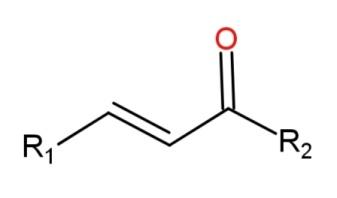
What is an alpha, beta – unsaturated ketone?
Answer
508.8k+ views
Hint: When any functional group is attached in a compound, then the carbon atom that is adjacent to that functional group is called alpha carbon and the hydrogen atoms on that carbon are alpha hydrogen. The carbon that is attached with alpha carbon is called the beta carbon and its hydrogen atoms are beta hydrogen.
Complete answer:
A ketone consists of the functional group called carbonyl group as$\left( -\overset{O}{\mathop{\overset{||}{\mathop{C}}\,}}\,- \right)$. This group is present in the middle of the carbon chain. The carbon attached with the carbon of this carbonyl group is called an alpha – carbon, while the carbon which is attached with the alpha carbon is called the beta – carbon. When a compound contains a double bond at this $\alpha ,\beta $- carbon alongside with the ketone group, then the compound is called an alpha, beta – unsaturated compound. The general structural formula for $\alpha ,\beta $- unsaturated ketone is,
 Where R are the alkyl groups
Where R are the alkyl groups
$\alpha ,\beta $- unsaturated ketones are formed as a result of ketol condensation that consist of reacting two ketones same or different in presence of a dilute alkali, which forms a ketol intermediate having an alcohol and a ketone group that on heating produces$\alpha ,\beta $- unsaturated ketone.
An example of self ketol condensation, where both ketones are same (propanone) is:

An example of cross ketol condensation, where both are different ketone is,

Hence, an alpha, beta – unsaturated ketone has a double bond on $\alpha ,\beta $- carbon adjacent to the ketone group.
Note:
For the molecules to undergo ketone reaction, it is important that the ketones possess alpha hydrogen, which are the hydrogens present on the carbon which is attached with the ketone group. Alpha hydrogen is acidic and attached with electron withdrawing groups, so the anion formed is stabilized by resonance.
Complete answer:
A ketone consists of the functional group called carbonyl group as$\left( -\overset{O}{\mathop{\overset{||}{\mathop{C}}\,}}\,- \right)$. This group is present in the middle of the carbon chain. The carbon attached with the carbon of this carbonyl group is called an alpha – carbon, while the carbon which is attached with the alpha carbon is called the beta – carbon. When a compound contains a double bond at this $\alpha ,\beta $- carbon alongside with the ketone group, then the compound is called an alpha, beta – unsaturated compound. The general structural formula for $\alpha ,\beta $- unsaturated ketone is,

$\alpha ,\beta $- unsaturated ketones are formed as a result of ketol condensation that consist of reacting two ketones same or different in presence of a dilute alkali, which forms a ketol intermediate having an alcohol and a ketone group that on heating produces$\alpha ,\beta $- unsaturated ketone.
An example of self ketol condensation, where both ketones are same (propanone) is:

An example of cross ketol condensation, where both are different ketone is,

Hence, an alpha, beta – unsaturated ketone has a double bond on $\alpha ,\beta $- carbon adjacent to the ketone group.
Note:
For the molecules to undergo ketone reaction, it is important that the ketones possess alpha hydrogen, which are the hydrogens present on the carbon which is attached with the ketone group. Alpha hydrogen is acidic and attached with electron withdrawing groups, so the anion formed is stabilized by resonance.
Recently Updated Pages
The number of solutions in x in 02pi for which sqrt class 12 maths CBSE

Write any two methods of preparation of phenol Give class 12 chemistry CBSE

Differentiate between action potential and resting class 12 biology CBSE

Two plane mirrors arranged at right angles to each class 12 physics CBSE

Which of the following molecules is are chiral A I class 12 chemistry CBSE

Name different types of neurons and give one function class 12 biology CBSE

Trending doubts
One Metric ton is equal to kg A 10000 B 1000 C 100 class 11 physics CBSE

What is 1s 2s 2p 3s 3p class 11 chemistry CBSE

Discuss the various forms of bacteria class 11 biology CBSE

State the laws of reflection of light

Explain zero factorial class 11 maths CBSE

An example of chemosynthetic bacteria is A E coli B class 11 biology CBSE




